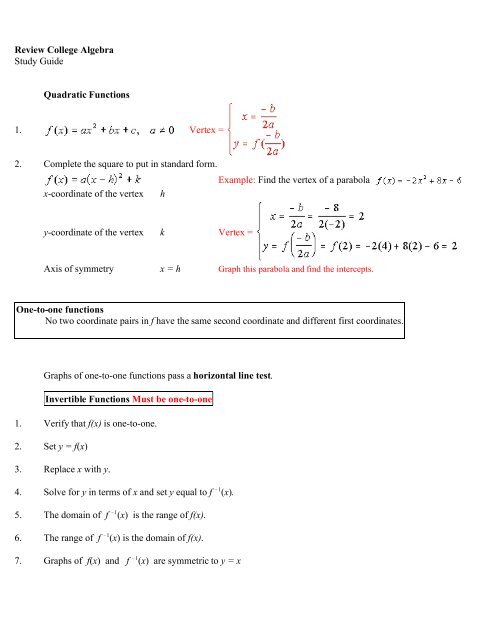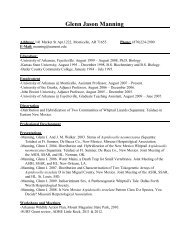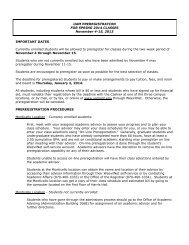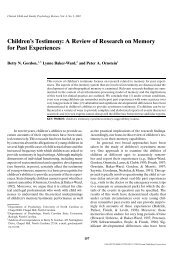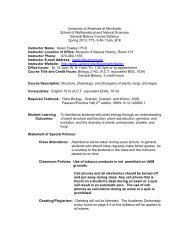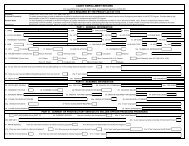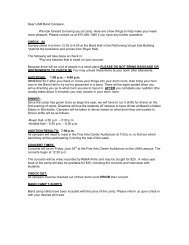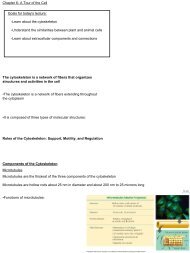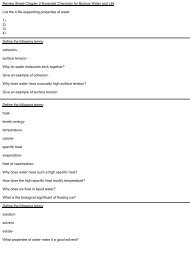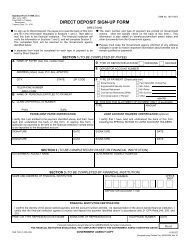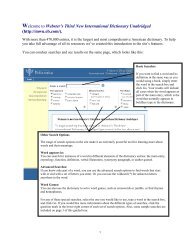Polynomials & Rational Functions, Inverse Functions
Polynomials & Rational Functions, Inverse Functions
Polynomials & Rational Functions, Inverse Functions
Create successful ePaper yourself
Turn your PDF publications into a flip-book with our unique Google optimized e-Paper software.
Review College Algebra<br />
Study Guide<br />
Quadratic <strong>Functions</strong><br />
1. Vertex =<br />
2. Complete the square to put in standard form.<br />
Example: Find the vertex of a parabola<br />
x-coordinate of the vertex h<br />
y-coordinate of the vertex k Vertex =<br />
Axis of symmetry x = h Graph this parabola and find the intercepts.<br />
One-to-one functions<br />
No two coordinate pairs in f have the same second coordinate and different first coordinates.<br />
Graphs of one-to-one functions pass a horizontal line test.<br />
Invertible <strong>Functions</strong> Must be one-to-one<br />
1. Verify that f(x) is one-to-one.<br />
2. Set y = f(x)<br />
3. Replace x with y.<br />
4. Solve for y in terms of x and set y equal to f 1 (x).<br />
5. The domain of f 1 (x) is the range of f(x).<br />
6. The range of f 1 (x) is the domain of f(x).<br />
7. Graphs of f(x) and f 1 (x) are symmetric to y = x
Example: Graph the function<br />
and its inverse with axis of symmetry.<br />
i) Set y = 2x 4<br />
ii) Replace x with y.<br />
x = 2y 4<br />
iii) Solve for y in terms of x and set y equal to f 1 (x).<br />
2y = x 4, ,<br />
Note the graphs of f(x) and f 1 (x) are symmetric about the line y = x.<br />
Exercise: Draw the inverse of the 1-1 function on the right.<br />
Exercise: Which of the following functions are one-to-one<br />
, ,<br />
Exercise:<br />
Find the inverse functions for the functions:(Horizontal Line Test)<br />
, , ,<br />
.
Polynomial <strong>Functions</strong><br />
1. Know what a polynomial is and know the general form of the equation of a polynomial. Be able to determine<br />
the end behavior of a polynomial and be able to find: zeros, intercepts, local extrema, and know how to sketch<br />
the graph of a polynomial. The following is a typical example:<br />
Example: Consider the polynomial<br />
. Find: The leading coefficient of, the degree of the<br />
polynomial, the right-hand and the left-hand behavior of the graph of the polynomial, the real zeros (xintercepts)<br />
of this polynomial, the y-intercept of the polynomial, and sketch the graph of this polynomial.<br />
i) n = 3 (Degree)<br />
ii) a = 1 (Lead Coefficient<br />
iii) Rises to the right or increases without bound as ,<br />
falls to the left or decreases without bound<br />
iv) Zeros: x = 2, x = 2 x = 3 (x-intercepts)<br />
v) Local Maximum: (2.53, 1.13), Local Minimum: (.53, 13.13)<br />
vi) Exercise: Graph the polynomial. Find the y-intercept.<br />
Exercises:<br />
1. Which one of the following is a polynomial<br />
a) b)<br />
c) d)<br />
For problems 2-4 let f (x) = 20x 4 + 5x 3 3x + 8.<br />
2. Find the y-intercept of f<br />
3. Find the degree of f<br />
4. Find the value of f (10)<br />
5. Sketch the graph of y = x (x + 2) 2 (x 3).<br />
Exercises:<br />
Find and label the x- and y- intercepts.<br />
Find the degree of this function<br />
i. Show that the following polynomials have at least one zero in the given intervals:<br />
, .<br />
ii. Show that the following polynomials equations have at least one root in the given intervals:
,<br />
iii. Let be a polynomial whose some of its values at various points are given in the table below. What can<br />
you say about the zeros of this polynomial in the given range<br />
8 2 0 2 4 9<br />
3 1 5 3 2 25<br />
<strong>Rational</strong> <strong>Functions</strong><br />
1. Know what a rational function is.<br />
2. Be able to find the domain of a rational function:<br />
3. Know what an asymptote of a rational function is.<br />
Be able to find the vertical and the horizontal asymptotes of a rational function.<br />
Exercise: Find the vertical and the horizontal asymptotes of rational functions:<br />
4. Be able to find the x-intercepts and the y-intercept of a rational function.<br />
Exercise: Find the x-intercepts and the y-intercept of the rational functions in the above exercise:.<br />
5. Be able to sketch or recognize graphs of rational functions.<br />
Exercise: Sketch the graphs of functions in the above exercise:.


